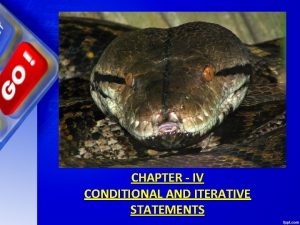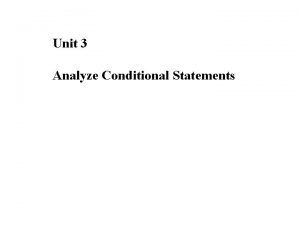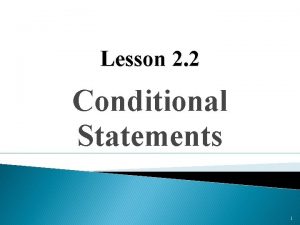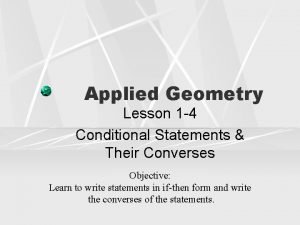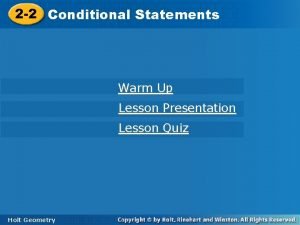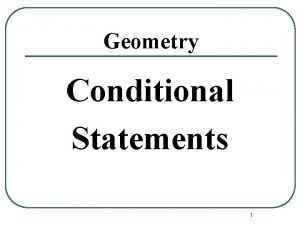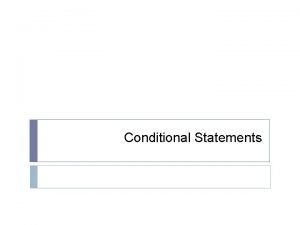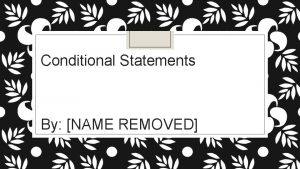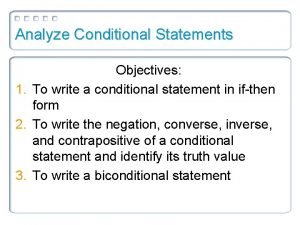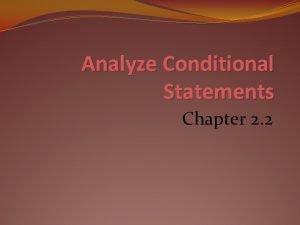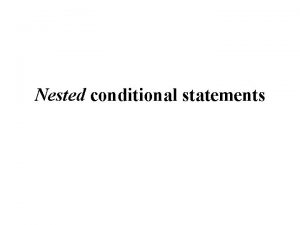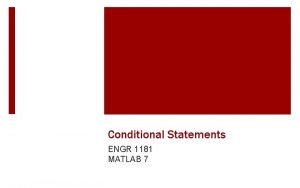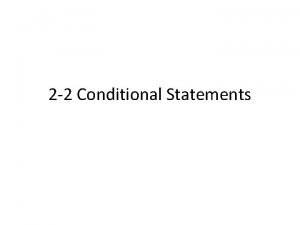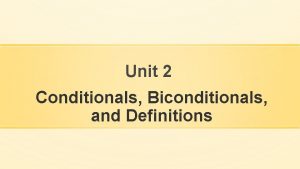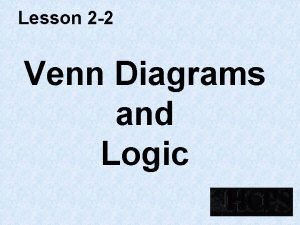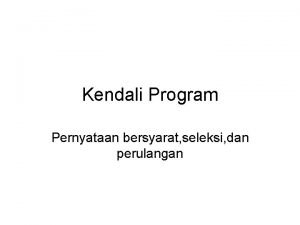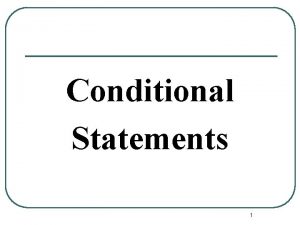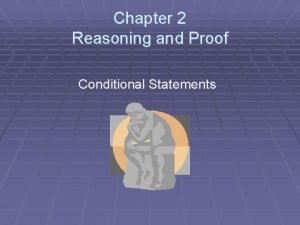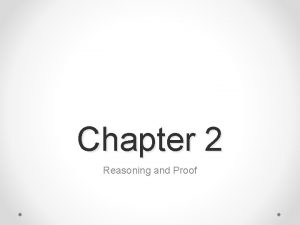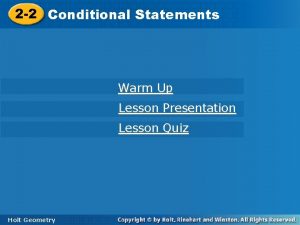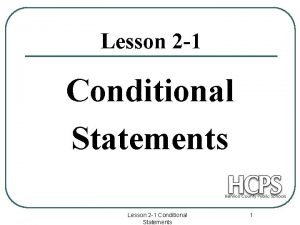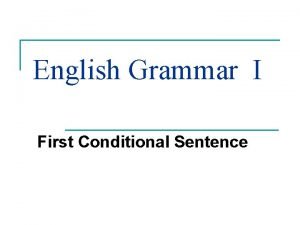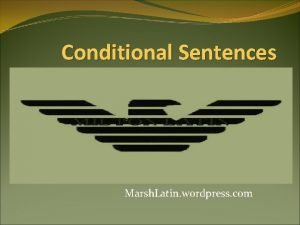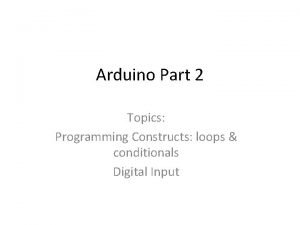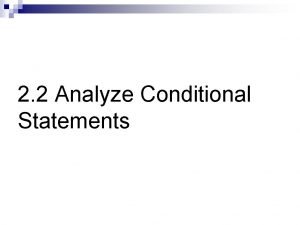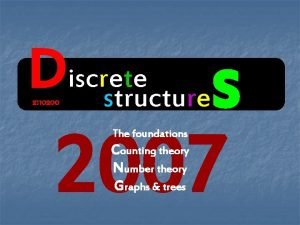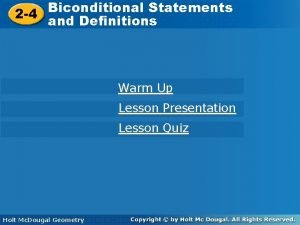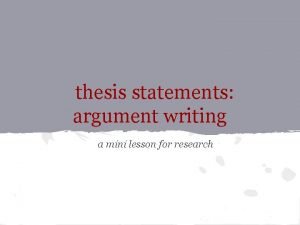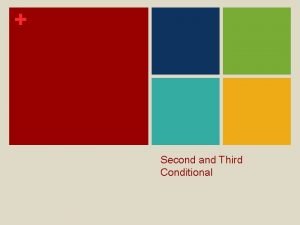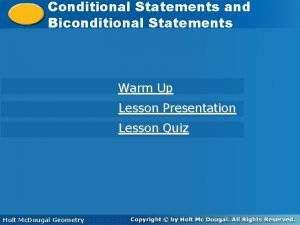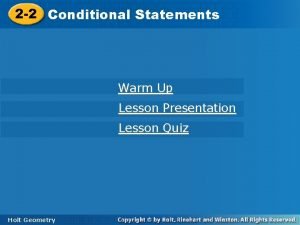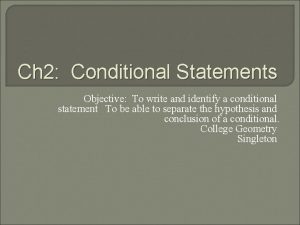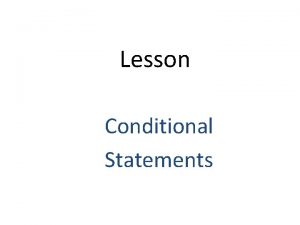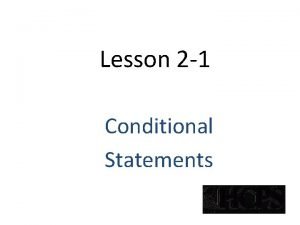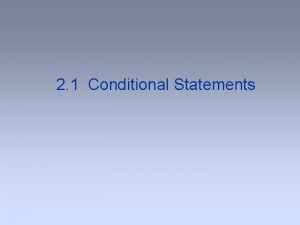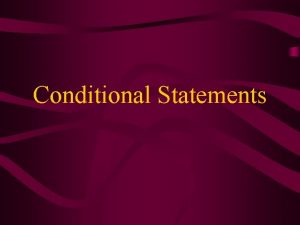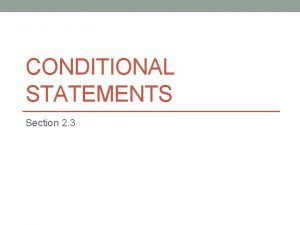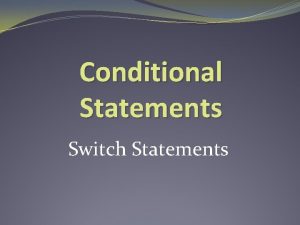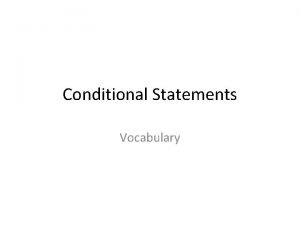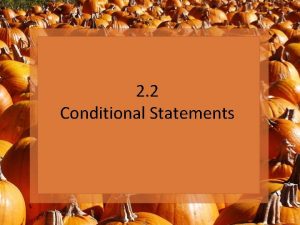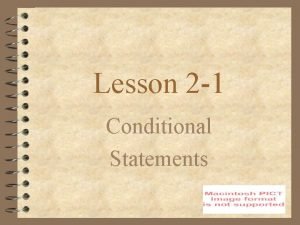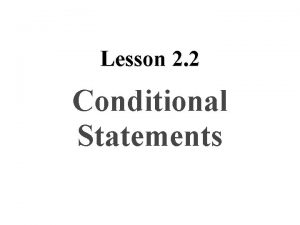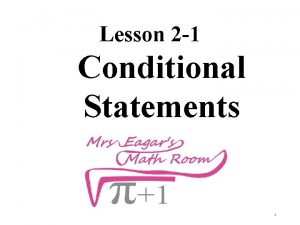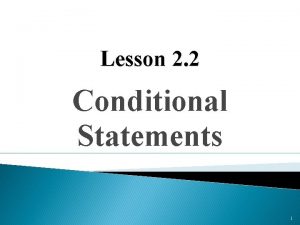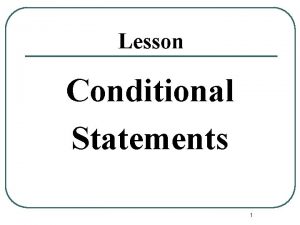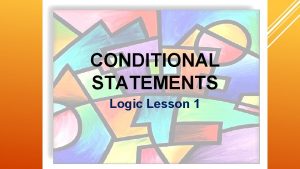Lesson Conditional Statements Conditional Statement Defn A conditional




































- Slides: 36

Lesson Conditional Statements

Conditional Statement Defn. A conditional statement is a statement that can be written as an ifthen statement. That is, as “If _______, then _______. ”

Example: If your feet smell and your nose runs, then you're built upside down.

Conditional Statements have two parts: The hypothesis is the part of a conditional statement that follows “if” (when written in if-then form. ) It is the given information, or the condition. If a number is prime, then a number has exactly two divisors. Leave off “if” and Hypothesis: a number is prime comma.

Conditional Statements have two parts: The conclusion is the part of a conditional statement that follows “then” (when written in if-then form. ) It is the result of the given information. If a number is prime, then a number has exactly two divisors. Leave off “then” and Conclusion: a number has exactly two divisors period

Rewriting Conditional Statements Conditional statements can be put into an “if-then” form to clarify which part is the hypothesis and which is the conclusion. Method: Turn the subject into a hypothesis.

Example 1: Vertical angles are congruent. can be written as. . . If two angles are vertical, then they are congruent.

Example 2: Seals swim. can be written as. . . If an animal is a seal, then it swims.

Example 3: Babies are illogical. can be written as. . . If a person is a baby, then the person is illogical.

IF …THEN vs. IMPLIES Another way of writing an if-then statement is using the word implies. Two angles are vertical implies they are congruent.

Conditional Statements can be true or false: • A conditional statement is false only when the hypothesis is true, but the conclusion is false. • A counterexample is an example used to show that a statement is not always true and therefore false.

Counterexample Statement: If you live in Virginia, then you live in Richmond, VA. Is there a counterexample? YES. . . Anyone who lives in Virginia, but not Richmond, VA. Therefore ( ) the statement is false.

Symbolic Logic Symbols can be used to modify or connect statements.

Symbols for Hypothesis and Conclusion Lower case letters, such as p and q, are frequently used to represent the hypothesis and conclusion. if p, then q or p implies q

Symbols for Hypothesis and Conclusion Example p: a number is prime q: a number has exactly two divisors if p, then q or p implies q If a number is prime, then it has exactly two divisors.

is used to represent the words “if … then” or “implies”

p q means if p, then q or p implies q

Example p: a number is prime q: a number has exactly two divisors p q: If a number is prime, then it has exactly two divisors.

~ is used to represent the word “not” • ~ p is the negation of p. • The negation of a statement is the denial of the statement. Add or remove the word “not. ” • To negate, write ~ p.

Example p: the angle is obtuse ~p: the angle is not obtuse Be careful because ~p means that the angle could be acute, right, or straight.

Example p: James doesn’t like fish. ~p: James likes fish. Notice: ~p took the “not” out… it would have been a double negative (not not)

is used to represent the word “and”

Example p: a number is even q: a number is divisible by 3 p q: A number is even and it is divisible by 3. 6, 12, 18, 24, 30, 36, 42. . .

is used to represent the word “or”

Example p: a number is even q: a number is divisible by 3 p q: A number is even or it is divisible by 3. 2, 3, 4, 6, 8, 9, 10, 12, 14, 15, . . .

is used to represent the word “therefore”

Example Therefore, the statement is false

Different Forms of Conditional Statements

Forms of Conditional Statements Converse: Statement formed from a conditional statement by switching the hypothesis and conclusion (q p) p q If two angles are vertical, then they are congruent. q p If two angles are congruent, then they are vertical. Are these statements true or false? Continued…. .

Forms of Conditional Statements Inverse: Statement formed from a conditional statement by negating both the hypothesis and conclusion. (~p ~q) p q : If two angles are vertical, then they are congruent. ~p ~q: If two angles are not vertical, then they are not congruent. Are these statements true or false?

Forms of Conditional Statements Contrapositive: Statement formed from a conditional statement by switching and negating both the hypothesis and conclusion. (~q ~p) p q : If two angles are vertical, then they are congruent. ~q ~p: If they are not congruent, then two angles are not vertical Are these statements true or false?

Contrapositives are logically equivalent to the original conditional statement. • If p q is true, then q p is true. • If p q is false, then q p is false.

Biconditional • When a conditional statement and its converse are both true, the two statements may be combined. • A statement combining a conditional statement and its converse is a biconditional. • Use the phrase if and only if which is abbreviated iff • Use the symbol

Definitions are always biconditional l Statement: p q l If an angle is right then it measures 90. l Converse: q p l If an angle measures 90 , then it is right. l Biconditional: p q l An angle is right iff it measures 90.

Biconditional • A biconditional is in the form: Hypothesis if and only if Conclusion. or Hypothesis iff Conclusion or Hypothesis Conclusion

Biconditionals in symbols Since p q means p q AND q p, p q Is equivalent to (p q) (q p)
 Iterative statements in python
Iterative statements in python Unit 3 lesson 1 conditional statements
Unit 3 lesson 1 conditional statements Conditional statment
Conditional statment Lesson 1 conditional statements
Lesson 1 conditional statements Lesson 2-2 conditional statements answer key
Lesson 2-2 conditional statements answer key Conditional statement geometry
Conditional statement geometry Conditional statement
Conditional statement 2-2 practice conditional statements
2-2 practice conditional statements Symbol for conditional statement
Symbol for conditional statement Bioconditional statement
Bioconditional statement Nested conditional statements definition
Nested conditional statements definition Time clauses conditionals
Time clauses conditionals Conditional statements matlab
Conditional statements matlab Inverse of the conditional statement
Inverse of the conditional statement Unit 2 homework 3 conditional statements
Unit 2 homework 3 conditional statements Venn diagram conditional statement
Venn diagram conditional statement Is for loop a conditional statement
Is for loop a conditional statement What is the definition of conditional statement
What is the definition of conditional statement Unit 2 logic and proof homework 3 conditional statements
Unit 2 logic and proof homework 3 conditional statements Complete the proof
Complete the proof 2-2 conditional statements
2-2 conditional statements Biconditional statement
Biconditional statement Conditional sentences first conditional
Conditional sentences first conditional Latin conditional clauses
Latin conditional clauses Arduino conditional statements
Arduino conditional statements Biconditional statement in java
Biconditional statement in java The nth statement in a list of 100 statements
The nth statement in a list of 100 statements Biconditionals and definitions quiz
Biconditionals and definitions quiz Mini lesson on thesis statements
Mini lesson on thesis statements Past real conditional examples
Past real conditional examples Conditional statement geometry
Conditional statement geometry Conditional statement
Conditional statement Conditional statement geometry
Conditional statement geometry Rewriting universal conditional statement examples
Rewriting universal conditional statement examples Conditional statement
Conditional statement Every pot has a lid conditional statement
Every pot has a lid conditional statement Conditional statement
Conditional statement
